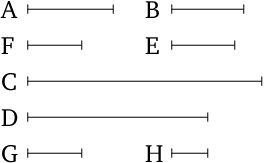Proof: By Euclid
(related to Proposition: 7.34: Existence of Least Common Multiple)
- For $A$ and $B$ are either prime to one another, or not.
- Let them, first of all, be prime to one another.
- And let $A$ make $C$ (by) multiplying $B$.
- Thus, $B$ has also made $C$ (by) multiplying $A$ [Prop. 7.16].
- Thus, $A$ and $B$ (both) measure $C$.
- So I say that ($C$) is also the least (number which they both measure).
- For if not, $A$ and $B$ will (both) measure some (other) number which is less than $C$.
- Let them (both) measure $D$ (which is less than $C$).
- And as many times as $A$ measures $D$, so many units let there be in $E$.
- And as many times as $B$ measures $D$, so many units let there be in $F$.
- Thus, $A$ has made $D$ (by) multiplying $E$, and $B$ has made $D$ (by) multiplying $F$.
- Thus, the (number created) from (multiplying) $A$ and $E$ is equal to the (number created) from (multiplying) $B$ and $F$.
- Thus, as $A$ (is) to $B$, so $F$ (is) to $E$ [Prop. 7.19].
- And $A$ and $B$ are prime (to one another), and prime (numbers) are the least (of those numbers having the same ratio) [Prop. 7.21], and the least (numbers) measure those (numbers) having the same ratio (as them) an equal number of times, the greater (measuring) the greater, and the lesser the lesser [Prop. 7.20].
- Thus, $B$ measures $E$, as the following (number measuring) the following.
- And since $A$ has made $C$ and $D$ (by) multiplying $B$ and $E$ (respectively), thus as $B$ is to $E$, so $C$ (is) to $D$ [Prop. 7.17].
- And $B$ measures $E$.
- Thus, $C$ also measures $D$, the greater (measuring) the lesser.
- The very thing is impossible.
- Thus, $A$ and $B$ do not (both) measure some number which is less than $C$.
- Thus, $C$ is the least (number) which is measured by (both) $A$ and $B$.

- So let $A$ and $B$ be not prime to one another.
- And let the least numbers, $F$ and $E$, have been taken having the same ratio as $A$ and $B$ (respectively) [Prop. 7.33].
- Thus, the (number created) from (multiplying) $A$ and $E$ is equal to the (number created) from (multiplying) $B$ and $F$ [Prop. 7.19].
- And let $A$ make $C$ (by) multiplying $E$.
- Thus, $B$ has also made $C$ (by) multiplying $F$.
- Thus, $A$ and $B$ (both) measure $C$.
- So I say that ($C$) is also the least (number which they both measure).
- For if not, $A$ and $B$ will (both) measure some number which is less than $C$.
- Let them (both) measure $D$ (which is less than $C$).
- And as many times as $A$ measures $D$, so many units let there be in $G$.
- And as many times as $B$ measures $D$, so many units let there be in $H$.
- Thus, $A$ has made $D$ (by) multiplying $G$, and $B$ has made $D$ (by) multiplying $H$.
- Thus, the (number created) from (multiplying) $A$ and $G$ is equal to the (number created) from (multiplying) $B$ and $H$.
- Thus, as $A$ is to $B$, so $H$ (is) to $G$ [Prop. 7.19].
- And as $A$ (is) to $B$, so $F$ (is) to $E$.
- Thus, also, as $F$ (is) to $E$, so $H$ (is) to $G$.
- And $F$ and $E$ are the least (numbers having the same ratio as $A$ and $B$), and the least (numbers) measure those (numbers) having the same ratio an equal number of times, the greater (measuring) the greater, and the lesser the lesser [Prop. 7.20].
- Thus, $E$ measures $G$.
- And since $A$ has made $C$ and $D$ (by) multiplying $E$ and $G$ (respectively), thus as $E$ is to $G$, so $C$ (is) to $D$ [Prop. 7.17].
- And $E$ measures $G$.
- Thus, $C$ also measures $D$, the greater (measuring) the lesser.
- The very thing is impossible.
- Thus, $A$ and $B$ do not (both) measure some (number) which is less than $C$.
- Thus, $C$ (is) the least (number) which is measured by (both) $A$ and $B$.
- (Which is) the very thing it was required to show.
∎
Thank you to the contributors under CC BY-SA 4.0! 

- Github:
-

- non-Github:
- @Fitzpatrick
References
Adapted from (subject to copyright, with kind permission)
- Fitzpatrick, Richard: Euclid's "Elements of Geometry"
